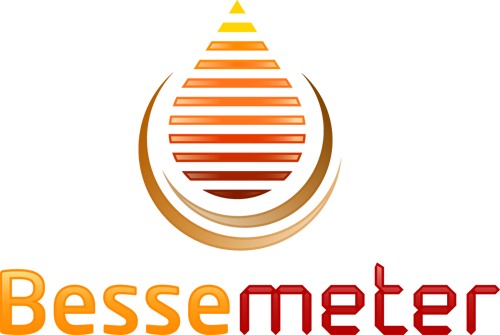Do Hobbyists Need Moisture Meters for Woodworking?
You might have heard different reports: some people say moisture meters are a waste of time and money. Others swear by them. Others aren’t sure.
That’s probably why you’re here.
Do hobbyists need moisture meters? After all, they aren’t operating a big woodworking business. It’s more of a just-for-fun DIY activity that spruces up your home into the bargain.
The answer is that everyone who works with wood should use a moisture meter, no matter the skill level or scale of operation. Not only will you ensure a reliable project, but you’ll save time, money, and more in the long run.
This article will tell you all about why moisture meters are so important, plus what types are out there and what to look for when buying one. Specifically, we’ll look at
- Why moisture meters are so important
- What the ideal moisture content for woodworking projects is
- When hobbyist woodworkers should use a moisture meter
- The best wood moisture meter for a hobbyist
Let’s first read why meters are such an essential tool in a woodworker’s box.
Why moisture meters are so important

A moisture meter is important to a woodworker of any skill level because it can save you time, money, reputation, and frustration.
Wood is a material that is influenced by its environment. It’s like a sponge—it absorbs or releases moisture to adjust to the air’s moisture content (MC), which is a combination of temperature and humidity.
If you try to use the wood for your project before it’s released or absorbed all the moisture necessary, you could have some disastrous outcomes.
The wood could shrink or swell, diminishing its appearance and compromising its usefulness. Glue could come undone, and fasteners could loosen. The wood itself could bow, crack, or cup—not only unsightly but perhaps dangerous.
You’ll probably have to redo the project. This wastes materials, money, and time. It could also be pretty upsetting and annoying to have all the hard work you spent on something erased with a big crack or warped boards!
If you check your wood for the proper MC before using it, you can avoid moisture damage in your projects.
Not only that, but you can save time and money by not having to repair or reconstruct your project when the wood fails.
But how do you know when the wood is ready? Read on to find out.
What the ideal moisture content for woodworking projects is
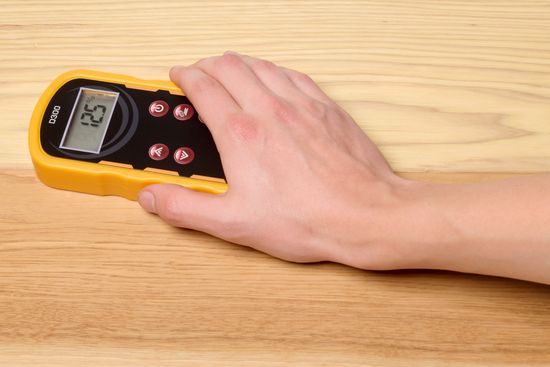
While using a moisture meter to determine the moisture content (or MC) in the wood is very helpful, you also need to know the EMC for your environment.
EMC (equilibrium moisture content) is a point reached when wood neither gains or loses moisture. It found the happy medium for that environment.
The EMC for wood is not the same for every place. Different regions of the world will have varying EMC numbers, and the EMC may not be the same even between inside and outside.
So how do you know what the EMC for your particular environment is? You can find out two ways.
First, you can do the calculation. The equation for finding EMC is
EMC = [-ln (1-ϕ) / 4.5 x 10^-5 (T + 460)] ^ 0.638
Where
ln = natural logarithm (a mathematical equation that calculates the time it takes to reach a specified point)
ϕ = relative humidity expressed as a decimal
T = temperature in Fahrenheit
The only problem with this equation is it’s a little confusing and can take a little while to calculate a moisture measurement.
So there’s also another option. You can look at a chart that lists EMC numbers of locations around the world.
Once you know your EMC, you can check the moisture of your wood to determine how close you are to the EMC for your area.
When should you check your wood with your moisture meter? Let’s find out.
When hobbyist woodworkers should use a moisture meter
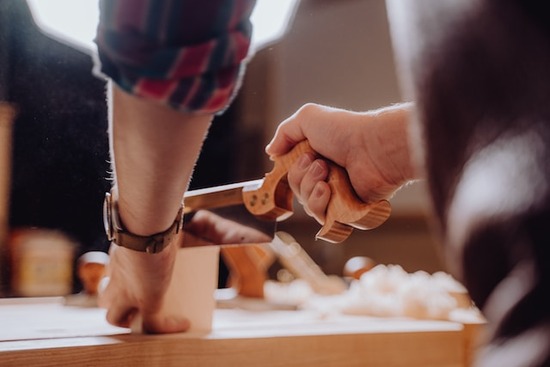
A hobbyist should always use a moisture meter before they start working with wood. In fact, you should use a moisture meter before even purchasing the wood.
You don’t want to get halfway into your project only to realize the wood is far too wet to be worked with yet! You might have to wait a long time for the wood to dry enough to use.
Another good time to check is during the project’s construction. This way, you can be sure the wood hasn’t altered its moisture content significantly and you’re still on track for a high-quality finished product.
While a moisture meter is useful for any project, there are some projects for which one is highly beneficial.
For example, cabinets are good projects to use a moisture meter for because they have so many pieces. Even if just one piece is off, the whole cabinet can get messed up.
Similarly, projects that involve long boards, like shelving or tables, need their moisture content checked. Highly warped bookshelves aren’t exactly in fashion, and a dining room table must be flat.
Wood you’re using to make hardwood flooring should also be checked with a moisture meter. So many small pieces have to fit perfectly together to make a wood floor, and an improper moisture content can easily lead to moisture damage down the road, including warping, cupping, or cracking.
Along with hardwood floors, building materials also need to be checked. While most lumber has been dried in kilns before you buy it, it’s better to be safe than sorry.
Using a moisture meter to carefully gauge the moisture will save you a lot of grief later. Your projects may look fine when the last sanding is done, but a week, a month, a year later, they might not.
Since we’ve seen how necessary moisture meters are, how do you know which is best? Let’s find out!
The best wood moisture meter for a hobbyist
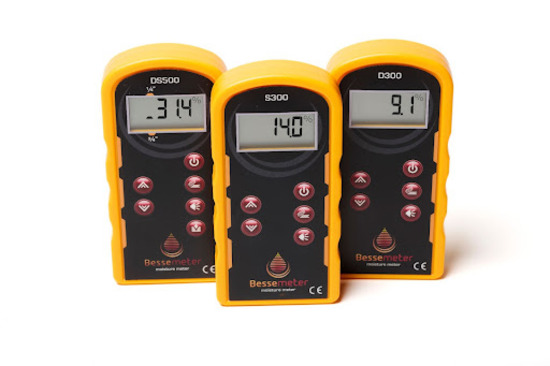
There are two types of moisture meters: pin and pinless.
Pin moisture meters use two metal probes—or pins—that stick into the surface of the wood. In the wood, these pins transmit electricity between each other and determine how much moisture the wood has through resistance.
Moisture conducts electricity, so the more resistance, the less moisture. The less resistance, the more moisture.
With a pinless moisture meter, there aren’t any pins. Instead, it has sensor pads that lay flat on the wood. It sends out electrical waves at a certain frequency, which makes an electromagnetic field under the sensor.
The waves are affected by the water in the wood. The changes in the waves determine the moisture content of the wood.
You could look at it this way: pin-type moisture meters measure moisture content between two points, while pinless meters measure the moisture content of a general area.
Both of these work well for hobbyists. Which one would be more valuable to you depends what kind of work you’re doing. Some wood shapes will return a more accurate reading with a pin meter (like curved surfaces) than a pinless meter, simply because of the way they work.
If you work mostly with flat surfaces, pinless meters might be a better choice.
Or, if you work with large amounts of wood, a pinless meter might be better. They take less time to set up and get readings from than pin meters.
While these are important things to consider before selecting a moisture meter, both have different features, which could play into your decision.
Let’s look at some of the big ones.
Moisture meter features
When a hobbyist—or anyone—is purchasing a moisture meter, it’s best to consider these important factors:
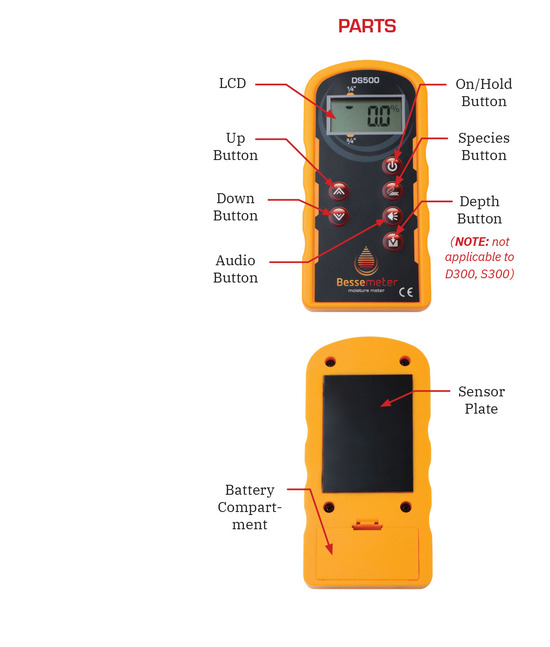
- Reading depth. Like most objects, wood dries from the outside in. If you have a moisture meter that only takes a shallow reading, you’ll have an inaccurate representation of the MC. How deep should you measure to get an accurate measurement? It really depends on the thickness of the wood. Some meters come with dual-depth measuring, where you can program your meter to read to different depths, like ¼ inch or ¾ inch. Pin meters measure at whatever depth the pins are, though you can switch pins with other lengths on some meters.
- Species adjustment. Depending on the moisture meter you have, different wood species will affect its reading. For example, the wood’s chemical makeup affects the reading of pin meters, while the wood density affects readings on pinless meters. A good-quality meter should have settings where you can change to different types of wood, and the meter will adjust for it. You’ll also want to know which kinds of wood you work with most before buying a meter. While good meters will have species adjustment, they might not have the wood you use.
- Repeatability. If you do a meter reading in the same place on the same piece of wood you did ten minutes ago, will it give the same MC? What about thirty minutes later? If it does, you have a moisture meter with good readability. If the meter does not give the same reading in that spot over and over again, it is unreliable and should not be used.
- Ease of use. You don’t want a meter that takes a while to set up and get positioned and programmed right. You want to be able to just whiz in, take several readings, and be done. Most people aren’t going to want to spend a lot of time taking moisture readings, especially multiple ones. The more complicated they are to use, the less you’ll want to use it or the more corners you’re going to try to cut. That will only give you inaccurate moisture content levels and make owning one pointless.
Here at Bessemeter, we have quality moisture meters that fit all these criteria to give you a reliable meter you’ll want to use before every project. Check out our line of moisture meters now!
